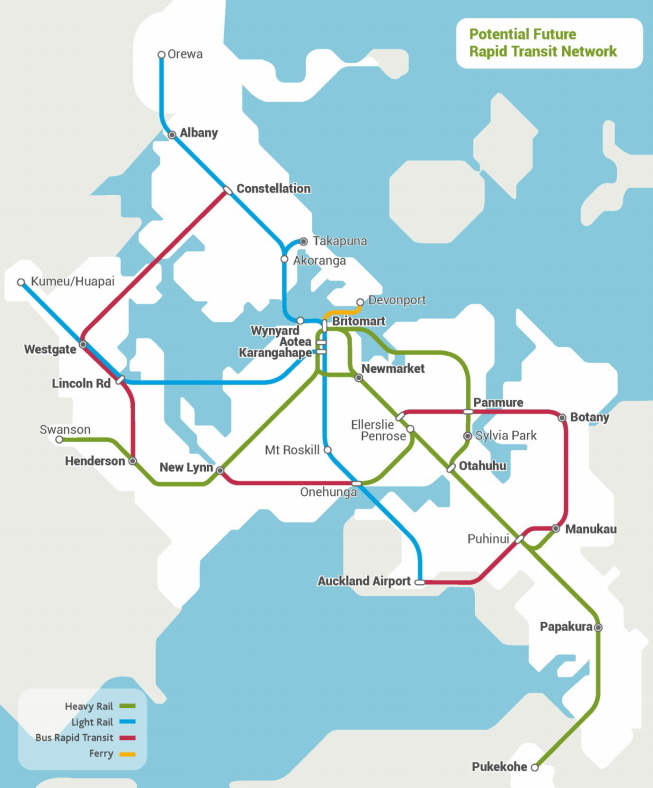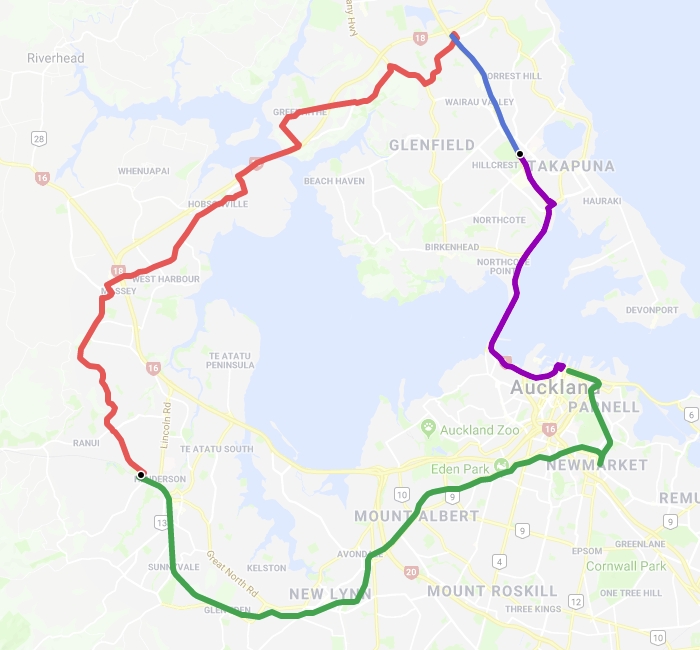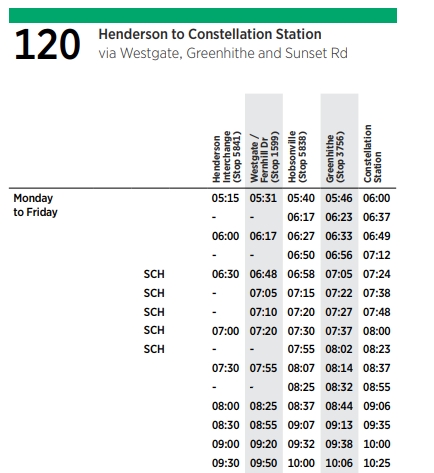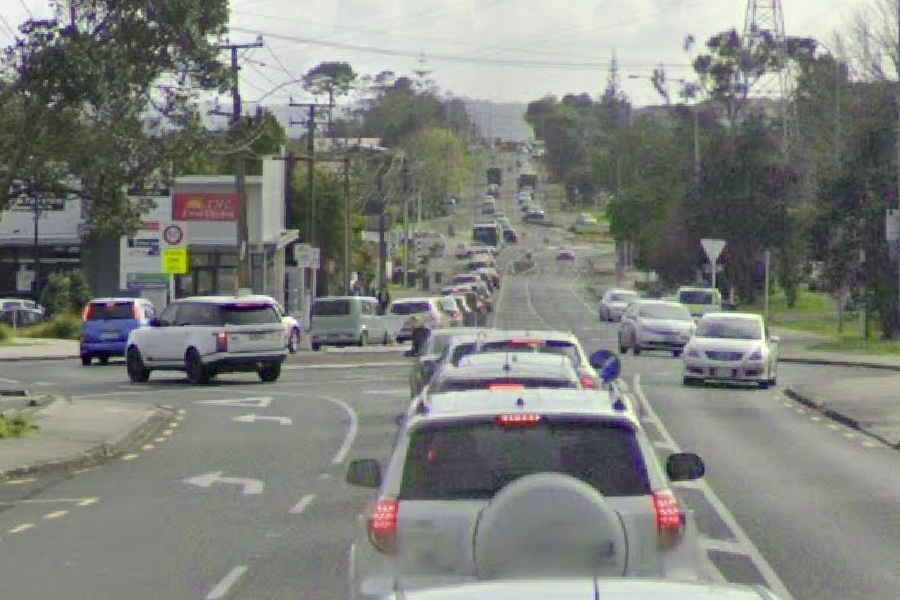If Auckland is to deliver the mode shift needed to meet our climate commitments and improve mobility we need to get substantially more people to use public transport. At a high-level this is not a difficult thing. While even ten years ago people might have argued that Aucklanders were somehow different and wouldn’t use PT, experience over that time has shown us that when we provide even moderately decent services that people will flock to use them. We can only imagine what could be achieved if we delivered region-wide, high-quality services.
The good news is that Auckland has some really good plans for improving public transport. These are outlined in documents like ATAP and in the Regional Public Transport Plan. The big problem with these plans is there is often no funding and put simply, they’re going to take too damn long to implement. We’re need to rapidly speed up the delivery of these.
One idea we’re particularly fond of is the idea of using similar plans to what is proposed for the Northwest to rapidly roll out improvements to other parts of the region. This is something we and others have talked about before and was also part of the Green Party transport policy this election. Recently I’ve once again been getting a first-hand look at just how important that could be.
As readers may know, I live out west near the Sturges Rd train station and work on the North Shore at Smales Farm. I commute by bike the equivalent of one day a week and use public transport on the other days. There are two main public transport options for this trip:
- Catch a train to the city and then get an NX1 bus to Smales Farm. There are some variations to this like described in this post.
- To catch the 120 bus via Upper Harbour and then to any of a number of services down the busway to Smales Farm. I wrote about trying it once before.
Typically I would always do option one, despite it being more expensive than option two, a 4-zone fare vs a 3-zone one. The main reason for this was trip reliability – not that the rail network didn’t have issues from time to time.
But during lockdown two we learnt the rail network was in such a poor state that all services would be slowed down to just 40km\h until Kiwirail could replace nearly half of the track on the network. As we emerged from Lockdown two I decided I’d give the 120 option a go again.
The first time trying it again was in the straight after we returned to level one, which happened to be during school holidays. This ended up being particularly useful as it has helped highlight what might be possible,
Before getting into my experiences, it’s useful to reference the timetable. The first issue you may notice is that the service only runs every 30 minutes from Henderson. This is nowhere near frequent enough but for this post let’s focus on the travel times.
Trip 1
I have been catching the bus that departs Henderson at 7:30 and it arrives just outside the Sturges Rd Station where I board from about 5 minutes later. After running through Massey the bus arrives at Westgate at about 7:50 whereby the driver then turns the bus off to wait for 7:55. This is a horror Inner and outer Link users will likely know all too well with the Victoria Park Pause.
At 7:55 we depart again and head down Hobsonville Rd arriving at Hobsonville stop just five minutes later, upon which time the driver once again turns the bus off and we sit waiting for seven minutes.
At 8:07, as per the timetable, we are once again on the move again and after detouring through Greenhithe we make our way to Constellation Station arriving at about 8:26, 11 minutes early. All passengers then proceed to walk across to the busway platforms to jump on the next NX1/NX2.
That’s a total Henderson to Constellation journey time of 56 minutes but it also included stoppage time of 12 minutes. In other words had the timetable been tighter, the journey could have been made in about 44 minutes instead of the scheduled 67 minutes.
Trip 2
I’ve taken a few trips since then but at the other end of the spectrum was my most recent trip. The bus arrived at my stop at 7:35 as it has for most trips and proceeds as normal till just after Massey High School. There it hits congestion that has been getting worse since school holidays ended. This is even captured on Google Streetview, albeit it a bit grainy. The congested patch runs for only about 500m from just south of Red Hills Rd to just north of Triangle Rd.
It’s not a long distance but the bus loses about five minutes of time during this section and arrives at Westgate right on 7:55 so we’re immediately on the go again once other passengers have boarded or alighted.
More traffic means a greater chance of missing light phases and so it then takes us a while to get through and past the Westgate motorway interchange. We travel down Hobsonville Rd and arrive at the Hobsonville stop at 8:07. The timetable is looking accurate at this point and we’re quickly on our way again.
After travelling through Greenhithe we cross over the motorway and my heart sinks as I see the lanes are jammed up with traffic. This is an ominous sign as when riding my bike I know that when this happens, a lot of people try to bypass it by using Upper Harbour Dr and that route quickly backs up. Sure enough that happens and we proceed to crawl the remaining 4.9km along Upper Harbour Dr, Albany Highway and Sunset Rd. The bus finally arrives at Constellation Station at 8:51 for a about an 81 minute journey.
The proto-RTN
It doesn’t take a transit expert to work out that a bus that only runs every half hour and one day could be somewhat fast and then take twice as long the next day is not going to be attractive. Yet despite this the bus seems to do fairly well for usage, something backed up by AT’s stats which show it busier than numerous frequent routes.
However, I can’t help but wonder just how popular a route like this would be if effort was put into making it reliably fast – either via this route or a more direct one. And that’s where the proto-RTN comes in.
The idea is fairly simple. The government has just recently approved funding to put some interim bus improvements on the Northwestern Motorway including bus stops on the motorway interchanges. What if we could do something similar on SH18 and on the other Rapid Transit routes where we’re otherwise not likely to see progress on a permanent solution for at least a decade or more.

As well as giving us faster journeys, even if the route isn’t up to the full RTN standard set by the Northern busway, such changes would enable AT to start marketing the network as a whole and combined I suspect we would see a lot more people happy to use it.

On top of just the RTN routes, AT really need to get on with their Connected Communities project which is aiming to improve some of our busiest bus corridors.




 Processing...
Processing...
Oh and another thing we really need to sort out is rules around letting buses out. Cumulatively multiple minutes after lost as far after car drives around a stopped bus preventing it from moving
Matt, this is low hanging fruit for the new Minister of Transport and should be introdued immediately.
This was part of the accessible streets package which was consulted on recently
https://www.nzta.govt.nz/assets/consultation/accessible-streets/accessible-streets-overview-to-the-rules.pdf
I wish the advocacy community would have a “Lessons Learned” retrospective on that legislation, and why it is languishing.
So many positive, sustainable, accessibility-enhancing improvements not going ahead because, essentially, of a call for purity in policy over pragmatic stepwise improvements.
It isn’t languishing. It is proceeding at the normal rate for legal reform. We can ask why that process is so slow, but not why this change is so slow.
This is law in British Columbia, Canada – “On any road in British Columbia where the speed limit is 60 km/h or slower, you must yield to a bus that is displaying the prescribed yield sign and is signalling that it wants to move out of the curb lane or bus stop.”
It’s a minor change that like you say, can add up to many minutes over the length of a bus route. More than likely the bus is going to pull in at the next bus stop, so the impact to car drivers is basically nil.
I’m pretty sure I read that it also the law in the UK.
I remember way back when bus use to have an Ad on the back asking motorist to let them go 1st and many use to do that . But now it all seems to be about money with the Ad’s on the back of buses .
That roundabout at Redhills Road is only going to get worse as the thousands of new houses are added between there and Westgate. I live just to the right of that photo and taking a right hand turn out of our street before 6am now involves waiting for a gap. Adding a form of RTN in the short to medium term is going to be critical or else we’ll see two commutes by car for every house that’s being added in addition to current, already congested levels of traffic.
Yes.
I occasionally take the 120 from Hobsonville Pt to Constellation. Like Matt this route is an extra Zone to CBD than routing via Westgate.
My observations:
1. This 120 route is absolutely ready for rapid treatment
2. Thanks to the planned stops, on-time performance for me is very good. There are even additional 120 services in the morning that leave from Hobsonville to improve frequency.
3. The Upper Harbour Drive detour is unnecessary. It’s usually congested and only picks up one or two passengers. A route change to enter the motorway at Greenhithe road, with bus priority on SH18 direct to Constellation would cut significant time and improve reliability.
re #3 – Yes could see that Sunset Rd area is already pretty well covered by other routes.
There are so many improvements to be made to bus transit in the city. I’m sure everyone on their route has places that could do with a bus (not bus only plz) lane here and another there. My current gripe is Newmarket and khyber pass road, the section where it’s 3 lanes, one bus lane, and a car lane in each direction. Huge numbers of busses, getting snarled up in car traffic. Needs to be single direction for cars and bi directional bus lanes. I type this sitting there in a half full double decker, not really moving.
Overall the current level of bus lanes can barely support the level of usage in a lot of key areas.
How long does the cycle take? I’d rather cycle than sit on a bus for 81mins.
The RTNs from city to Kumeu and Henderson to Constellation look good. They’re an elephant that need to be eaten one bite at a time. I think it has to start with the hardest piece, Western Springs / Grey Lynn shops to Karangahape station, following the motorway. This should be done as some sort of rail, as this portion of the route is already a bus RTN (Gt Nth Rd). Following this extend to and open PtChev station 6 months later, and so on.
I only have an analogue bike and it usually takes just over an hour
I guess on the bright side you could shift east or shift west and your journey would get shorter.
Lol. Or north or south, actually…
This is such a good post, Matt.
If transport planning is going to use travel time savings in business cases, then rather than using cooked times without full induced traffic effects, how about the sector uses travel time savings based on real life examples like this? Multiplied by the number of people who would use it if the service was frequent, reliable and quick – not the number of people who are using it now.
Despite those low hanging fruit improvements sounds easy and useful, AT won’t do much.
The senior managements are all focus on the the next biggest project that can be put on CV. Those small tweaks are left untouched for decades to come.
Staff who wants to fix things ends up become redundant because of ‘cost cutting’.
The whole organization has big issue with accountability, leadership and motivation.
Replacing CEO does not fix the problem. The problem is the failed experiment of CCO.
Absolutely. I know people that work in AT and they say the amount of managers on top of managers etc is quite simply ridiculous. Most of them don’t do anything, get the feather in their cap and bugger off while the next one tries to reinvent the wheel again all the while earning big 6 figure salaries!
Say for arguments sake there are 100 too many managers at AT. That could quite easily result in a wage bill of over $15m each year!
The problem is lack of accountability, everyone covers their own ass and no one really is holding management to account since it is kept at arms length from AC.
I am not familiar with the area but I wonder if it was going to be a pop up RTN then would it still go past Sturges Road Station or would there be a better route. In which case it would be better for some but not for Matt.L. There always seems to be winners and losers with any public transport change. Still its a good idea to experiment as you never know when your usual route will be super congested or cancelled if its on a train. I once sent a desperate passenger to the CDB via Botany from Manukau when all train services were cancelled. I wonder if he got there. With the new network there seems to be a range of options.
Yeah it’s more likely it would go down Lincoln Rd but that too wouldn’t be much use unless there was decent priority.
My own close-to-home example of AT still making offerings to the ‘traffic flow’ gods, in this case by aiming to improve evening peak flow. After being stuck at an intersection which skipped side street cycles (causing other drivers to simply push out on a red due to the assumption it was short phasing) I submitted an AT ticket online and received the following response:
“Auckland Transport is currently optimising the operation of the traffic lights on Te Atatu Road from the motorway interchange to Edmonton Road with a focus on the evening peak traffic travelling southwest on Te Atatu Road. As part of this optimisation we are trialling different options for the management of the flow from side streets onto Te Atatu Road. Your feedback from this enquiry has been passed to the optimisation engineer and will be taken into account as this process continues.”
In other words, in order to ensure maximum flow on and off our motorways, AT is making it even harder to get around one’s own suburb.
It’s worth noting too that the testing they were doing involved skipped the pedestrian crossing phase too which gets me even more riled up.
Spot on, Luke.
This Network Optimisation process is what is creating hellholes for locals, most particularly pedestrians and cyclists.
Why don’t the AT Board look into the details? Surely it just takes ones analytical thinker to be able to look at their optimisation and realise that when they’re not optimising the right variables (and walking and cycling and people-friendly places are considered tack-ons, not part of the actual computation) then this does not constitute optimisation.
It embarrasses me, as an engineer.
Heidi
It just seems bizarre in a climate challenged world that AT has this obsession with enabling more cars to move about, with a likely increase in vkt and consequently in carbon emissions.
Interesting example, and gee I wonder where a lot of the traffic has come from? The WRR/Waterview Tunnel.
I wonder if there is merit in breaking up the route in the interim given the Westgate to Constellation section is roughly at least 15kms even if you used SH18 from Greenhithe to Constellation (even more for the extra “school” weekday runs that continue onto Akoranga). Focus on getting bus priority etc through on this section then work on the Henderson to Westgate. That way you can have a faster accurate timetable for this section at least, delivered earlier?
In saying that seem there is vast lengths of Swanson & Don Buck Rd with a median which width could be made use of for at least peak hour bus lanes.
Talking about PT in isolation of PT – land use integration is flawed.
The government should be acquiring lots of sites near centers and RTN nodes and building thousands of apartments. Sell them at cost to first home buyers kills two birds (housing and climate crises) with one stone.
Yes. And being in charge of the development, can make sure they are designed to meet all Government’s and Council’s social and environmental goals.
In other news: on Birkenhead Avenue (which is part of the Birkenhead – Constellation Station line), AT did a modest proposal last year for a few 100m of transit lanes.
The result of the consultation is the transit lane gets truncated because we of course need the separate turning lanes for cars on the intersection at Onewa Road.
Hopeless, AT.
You just don’t get the fundamentals, and it’s costing the city everything.